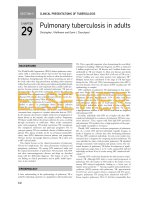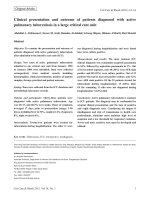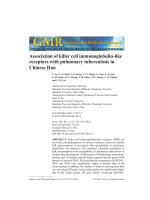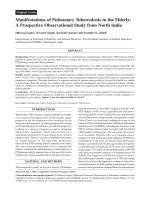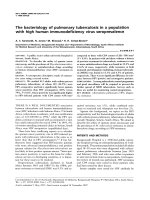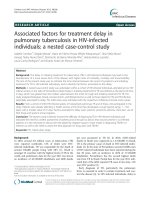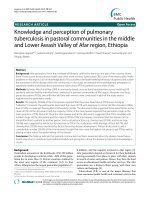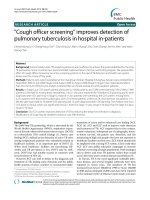PULMONARY TUBERCULOSIS IN HIV INFECTION IN TANZANIA clinical and immunological studies pdf
Bạn đang xem bản rút gọn của tài liệu. Xem và tải ngay bản đầy đủ của tài liệu tại đây (1.47 MB, 234 trang )
PDF hosted at the Radboud Repository of the Radboud University
Nijmegen
This full text is a publisher's version.
For additional information about this publication click this link.
[ />
Please be advised that this information was generated on 2013-01-07 and may be subject to
change.
PULMONARY TUBERCULOSIS IN HIV INFECTION
IN TANZANIA
clinical and immunological studies
Gibson S. Kibiki
2
3
PULMONARY TUBERCULOSIS IN HIV INFECTION
IN TANZANIA
clinical and immunological studies
Een wetenschappelijke proeve op het gebied van de Medische
Wetenschappen
Proefschift
ter verkrijging van de graad van doctor
aan de Radboud Universiteit Nijmegen,
op gezag van de rector magnificus prof. mr. S.C.J.J. Kortmann,
volgens besluit van het College van Decanen
in het openbaar te verdedigen op woensdag 27 juni 2007
om 13.30 uur precies
door
Gibson Sammy Kibiki
geboren te Njombe, Iringa, Tanzania.
4
Promotores: Prof. dr. W. M. V. Dolmans
Prof. dr. J.F. Shao (KCMC, Tanzania)
Copromotor: Dr. A. van der Ven
Manuscript commissie: Prof. dr. P. E. Verweij
Prof. dr. J. Van der Velden
Prof. dr. M. W. Borgdorff (AMC – Amsterdam)
5
The studies presented in this thesis were supported by PRIOR through a
grant from NWO / WOTRO, except the study in Chapter two which was
supported through Duke University (USA), and the study in Chapter eight
which was sponsored by University of Virginia, Center for Global Heath
Pfizer Initiative (USA).
dedication
To my children
In memory of my mother and father
7
Contents
Chapter 1 Introduction and outline of the thesis
Chapter 2 HIV-associated morbidity, mortality and diagnostic testing
opportunities among inpatients at a referral hospital in northern
Tanzania
Chapter 3 Aetiology and presentation of AIDS–associated pulmonary
infections at a referral hospital in northern Tanzania
Chapter 4 Human Herpes viruses in bronchoalveolar lavage fluid of HIV
infected Tanzanians with tuberculosis or other lung disease
Chapter 5 Laboratory diagnosis of pulmonary tuberculosis in TB and HIV
endemic settings and the contribution of real time PCR for
M. tuberculosis in bronchoalveolar lavage fluid
Chapter 6 M. tuberculosis genotypic diversity and drug susceptibility pattern in
HIV-infected and non-HIV-infected patients in northern Tanzania
Chapter 7 Serum and BAL macrophage migration inhibitory factor levels in
HIV infected Tanzanians with pulmonary tuberculosis or other lung
diseases
Chapter 8 Bronchoalveolar neutrophils, interferon gamma-inducible protein 10
and interleukin-7 in AIDS-associated tuberculosis
Chapter 9 The toll-like receptor 4 Asp299Gly variant and tuberculosis
susceptibility in HIV-infected patients in Tanzania
Chapter 10 General discussion and avenues for future research
Summary
Curriculum vitae
List of publications
8
Chapter 1
General introduction and outline of the thesis
Chapter One: Introduction and outline of the thesis
10
INTRODUCTION
Tuberculosis: The HIV factor
Of the 40 million persons living with HIV/AIDS to-date, over 60 percent
reside in sub-Saharan Africa, making it the most affected region of the
world, Figure 1 (1;2). HIV infection rate is still on the increase. In 2006
alone of the estimated world total of 4.3 million (3.6 – 6.6 million) new
HIV infections, sub-Saharan Africa was estimated to have 2.8 million (2.4
– 3.2 million) adults and children infected with HIV. This was more than
all other regions of the world combined together (2). The 2.1 million AIDS
deaths in sub-Saharan Africa represented 72% of global AIDS death (2).
Figure 1. Adults and children estimated to be living with HIV/AIDS
(UNAIDS, 2004)
In Tanzania in particular, at the end of 2005, the estimated number of
adults and children who were living with HIV was 1.4 million (1.3 – 1.6
million), making Tanzania one of the most affected countries in the world
Western & Central
Europe
6
6
1
1
0
0
0
0
0
0
0
0
[
[
4
4
8
8
0
0
0
0
0
0
0
0
–
–
7
7
6
6
0
0
0
0
0
0
0
0
]
]
North Africa & Middle
East
5
5
4
4
0
0
0
0
0
0
0
0
Sub-Saharan Africa
2
2
5
5
.
.
4
4
m
m
i
i
l
l
l
l
i
i
o
o
n
n
Eastern Europe
& Central Asia
1
1
.
.
4
4
m
m
i
i
l
l
l
l
i
i
o
o
n
n
[
[
9
9
2
2
0
0
0
0
0
0
0
0
–
–
2
2
.
.
1
1
m
m
i
i
l
l
l
l
i
i
o
o
n
n
]
]
South & South-East Asia
7
7
.
.
1
1
m
m
i
i
l
l
l
l
i
i
o
o
n
n
[
[
4
4
.
.
4
4
–
–
1
1
0
0
.
.
6
6
m
m
i
i
l
l
l
l
i
i
o
o
n
n
]
]
Oceania
3
3
5
5
0
0
0
0
0
0
[
[
2
2
5
5
0
0
0
0
0
0
–
–
4
4
8
8
0
0
0
0
0
0
]
]
North America
1
1
.
.
0
0
m
m
i
i
l
l
l
l
i
i
o
o
n
n
[
[
5
5
4
4
0
0
0
0
0
0
0
0
–
–
1
1
.
.
6
6
m
m
i
i
l
l
l
l
i
i
o
o
n
n
]
]
Caribbean
4
4
4
4
0
0
0
0
0
0
0
0
[
[
2
2
7
7
0
0
0
0
0
0
0
0
–
–
7
7
8
8
0
0
0
0
0
0
0
0
]
]
Latin America
1
1
.
.
7
7
m
m
i
i
l
l
l
l
i
i
o
o
n
n
[
[
1
1
.
.
3
3
–
–
2
2
.
.
2
2
m
m
i
i
l
l
l
l
i
i
o
o
n
n
]
]
East Asia
1
1
.
.
1
1
m
m
i
i
l
l
l
l
i
i
o
o
n
n
[
[
5
5
6
6
0
0
0
0
0
0
0
0
–
–
1
1
.
.
8
8
m
m
i
i
l
l
l
l
i
i
o
o
n
n
]
]
64%
Chapter One: Introduction and outline of the thesis
11
(2). It was projected that in Tanzania new infections and death will
increase steadily to reach 250,000 and 120,000 cases per year,
respectively in 2010, Figures 2,3,4 (3).
Figure 2. Estimates and projections of HIV infection among adult
Tanzanians from 1980 to 2010
Chapter One: Introduction and outline of the thesis
12
Figure 3. Estimates and projections of new cases of HIV infection among
adult Tanzanians from 1980 to 2010
Figure 4. Estimates and projections of aids deaths among adult
Tanzanians from 1980 to 2010
Chapter One: Introduction and outline of the thesis
13
Mycobacterium tuberculosis (MTB) is the world’s most deadly bacterial
pathogen (4). About one-third of the world population is infected with
MTB. By 2000 there were 8.3 million new cases and up to 2.2 million
deaths per year due to tuberculosis (TB) (5). HIV infection is a potent risk
factor for TB. The interaction of TB and HIV is formidable: rates of active
TB are higher in HIV infected persons than in persons without HIV,
because HIV increases the risk of reactivation of latent MTB (6) as well as
the risk of rapid TB progression after infection or reinfection with MTB (7).
HIV also increases TB transmission rates in the general community (8).
Patients co-infected with TB/HIV exhibit higher rates of mortality than
CD4-matched controls with TB but without HIV infection (9). The TB
burden in countries with a generalized HIV epidemic has therefore
increased rapidly over the past couple of decades, especially in the
severely affected countries of eastern and southern Africa (2;10) Figure
5. In these countries up to 31% of new TB cases are attributed to HIV
infection (5). In Tanzania, new TB cases increased five fold from 11,753
in 1983 to 61,603 in 2001 largely due to HIV/AIDS (11). TB therefore has
become the most common disease associated with HIV/AIDS and the
leading cause of morbidity and mortality (12).
Unlike the straightforward diagnosis and typical presentation of
pulmonary tuberculosis (PTB) in HIV-1 seronegative individuals (13;14),
PTB in HIV/AIDS frequently has atypical clinical and radiographic
presentation (15-17). Often PTB is hardly distinguishable from other
Chapter One: Introduction and outline of the thesis
14
causes of pulmonary infection on clinical and radiographic basis (18). This
makes the diagnosis of TB in HIV infection considerably difficult,
particularly in view of the resource limitations in the highly affected
countries of sub-Saharan Africa. This amounts to delayed diagnosis and
treatment, which affect the control strategies. To-date HIV infection is the
single most potent factor for increase in TB morbidity and mortality in the
African sub-continent.
Consequently, this deadliest TB/HIV tandem will result into approximately
one billion new MTB infections in the world, over 150 million people with
TB disease, and up to 36 million deaths due to TB between now and 2020
if the current trend is not abated (www.iuatld.org. 2002).
Chapter One: Introduction and outline of the thesis
15
This alarming magnitude of the TB disease asks for renewed and
alternative control strategies directed mainly to the most affected regions
“the TB/HIV Hot spots”. Researches are needed specifically from these
“Hot spots” to understand the pathophysiology behind TB disease in HIV
co-infection. Relevant research questions are for instance; why do some
individuals develop the disease while other don’t?, what are the
mechanisms leading to the atypical presentation of the disease?, what are
the factors associated with high mortality?, what are the current MTB
subtypes in the wake of high transmission rate due to HIV infection? We
Fi
g
ure 5. Tuberculosis cases per 100,000 people (2001)
Source: Globalis/UNEP/Global Virtual
Chapter One: Introduction and outline of the thesis
16
equally need to take bold operational approaches by re-evaluating PTB
diagnostic methods in HIV infection given the sputum scarcity associated
with AIDS (19) and by monitoring the effectiveness of currently used
antibiotics for TB treatment.
Current information available from sub-Saharan Africa on TB/HIV co-
infection is insufficient: studies from this most affected part of the globe
are sparse and not optimal. Only in few studies on TB in HIV infection
from this region samples from the bronchoalveolar compartment (i.e.
bronchoalveolar lavage fluid) have been used. This is important for better
understanding the disease as the actual events take place in the
broncholveolar parts of the lungs, and because of the sputum scarcity in
AIDS patients (19). Accurate diagnosis of TB is important in
understanding and characterizing the disease. Combination of
microbiological and molecular techniques offers a more accurate diagnosis
of TB and avoids erroneously assigning a patient as either TB positive or
negative. However data on such an approach for diagnosing TB are
lacking from this part of the world. Similarly, from this region no studies
are available which characterize a broad range of cytokines and their
interaction in TB/HIV co-infection. Such an approach is important given
the immunological complexity associated with HIV infection.
For this reason we conducted pathophysiological and operational studies
in an attempt to shed more light on the TB/HIV co-infection in a sub-
Chapter One: Introduction and outline of the thesis
17
Saharan African country, using bronchoalveolar lavage fluid from
accurately defined TB patients with HIV co-infection. All subjects studied
in this work were indigenous Tanzanians, i.e. a true representation of one
of the most affected countries of sub-Saharan Africa (10)
Chapter One: Introduction and outline of the thesis
18
Outline of the thesis
Chapter 1.
In the introductory chapter the complex relationship between
pulmonary tuberculosis (TB) and HIV infection is highlighted in the
context of the HIV epidemic in tropical Africa and Tanzania in
particular. Also, an outline is given of the research reported in the
following chapters of this thesis.
Chapter 2.
In this study the ten-year trend in leading causes of hospitalisation
and in-hospital morbidity and mortality attributed to HIV-infection is
examined in a tertiary health care facility in northern Tanzania.
Also, the prevalence of HIV infection in in-patients and the
proportion of patients unaware of HIV infection as the cause of their
ailing health are examined.
Chapter 3.
In this chapter the aetiological agents of pulmonary infection in a
cohort of adult HIV infected patients are determined and correlated
with the levels of immunosuppression, clinical presentation, chest
radiographic findings and prognosis.
Chapter 4.
Due to an ongoing breakdown of cellular immunity in TB/HIV dual
infection, the host is subject to a variety of infections including
viruses. In this study we determine the prevalence of the most
Chapter One: Introduction and outline of the thesis
19
common human herpes viruses in bronchoalveolar lavage (BAL)
fluid and discuss their possible contribution to the high mortality in
patients with TB/HIV co-infection.
Chapter 5.
Accurate microbiological diagnosis is crucial for TB control in the era
of TB/HIV co-infection, particularly since clinical and radiographic
features cannot adequately differentiate TB from other causes of
pulmonary infection. In this study data are presented on the
performance of diagnostic laboratory tests for pulmonary TB,
including microbiological, serological and molecular methods
(including real time PCR), using sputum, bronchoalveolar lavage
fluid and serum in a TB and HIV endemic setting.
Chapter 6.
This chapter presents the results of a study into the dominant
genotypes of Mycobacterium tuberculosis (MTB), determined by
spoligotyping, in HIV infected and non-HIV patients in Tanzania.
The genotypes are correlated with anti-TB drug sensitivity patterns.
Also, the results of genotypic and phenotypic anti-TB drug
susceptibility testing are compared.
Chapter One: Introduction and outline of the thesis
20
Chapter 7.
In patients not infected with HIV, the role of macrophage migration
inhibitory factor (MIF) in the course of MTB infection showed that
MIF levels were determined by dose and virulence of the MTB strain
and that high MIF levels were associated with fatal outcome. We
report data on MIF in HIV infected patients with pulmonary TB or
other pulmonary infections compared to TB patients without HIV
infection and healthy controls. Also, the association of MIF levels
with mortality is examined.
Chapter 8.
Our understanding of atypical presentation of tuberculosis in
advanced AIDS, such as the lack of upper lobe cavitation, is
insufficient. In particular it is not clear which events take place at
the site of infection in the lungs. This study examines the local
immune response in HIV infected patients with TB compared with
HIV infected patients with non-TB pulmonary disease from
Tanzania, using bronchoalveolar lavage (BAL) fluid. It correlates
chest radiographic features and CD4 T cell level with levels of a
panel of cytokines/chemokines present in BAL.
Chapter One: Introduction and outline of the thesis
21
Chapter 9.
Infection with MTB is common to citizens of sub-Saharan Africa,
however only a proportion of individuals develop active TB while in
the majority the disease remains latent. Toll-like receptors (TLR)
are important for host defence against MTB. TLR4 299 functional
polymorphism is common in sub-Saharan Africa. Therefore, we
investigated the association between TLR4 Asp 299Gly
polymorphism and the development of active TB in HIV infected
patients and examined whether there was an association with level
of CD4 T cells.
Chapter 10.
This chapter discusses the findings from the above studies, puts the
findings into perspective, and winds up by outlining avenues for
future research.
Chapter One: Introduction and outline of the thesis
22
Reference List
(1) Anon. AIDS epidemic update: December 2002. Geneva: Joint United
Nations Programme on HIV/AIDS (UNAIDS). 2002.
(2) Anon. AIDS epidemic update: December 2006. Geneva: Joint United
Nations Programme on HIV/AIDS (UNAIDS). 2006.
(3) Somi GR, Matee M, Swai OR, Lyamuya FE, Killewo J, Kwesigabo G, Tulli T,
Kabalimu KT, Ng'ang'a L, Isingo R, Ndayongele J. Estimating and
projecting HIV prevalence and AIDS deaths in Tanzania using antenatal
surveillance data. BMC Pulm Med 2006;6(120).
(4) WHO. World Health Organization. Geneva. 2004.
(5) Corbett EL, Watt CJ, Walker N, Maher D, Willams BG, Raviglione MC, Dye
C. The growing burden of tuberculosis. Global trend and interactions with
the HIV epidemic. Arch Intern Med 2003;163:1009-21.
(6) Butcher HC, Griffith LE, Guyatt GH, Sudre P, Naef M, Sendi P, Battegay M.
Isoniazid prophylaxis for tuberculosis with in HIV infection: Meta-analysis
of randomized controlled trials. AIDS 1999;13:501-7.
(7) Daley CL, Small PM, Schecter GF, Schoolnik GK, McAdam RA, Jacobs WR,
Jr., Hopewell PC. An outbreak of tuberculosis with accelerated progression
among persons infected with the human immunodeficieny virus: an
analysis using restriction-fragment-length-polymorphisms. N Engl J Med
1992;326:231-5.
Chapter One: Introduction and outline of the thesis
23
(8) Odhiambo JA, Borgdorff MW, Kiambih FM, kibuga DK, Kwamanga DO,
Ng'ang'a L, Agwanda R, KalisvaartN A, Miljenovic O, Nagelkerke NJ,
Bosman M. Tuberculosis and HIV the epidemic: increasing annual risk of
infection in Kenya. 1986 - 1996. Am J Public Health 1999;89:1078-82.
(9) Whalen CC, Nsubuga P, Okwera A, Johnson JL, Hom DL, Michael NL,
Mugerwa RD, Ellner JJ. Impact of pulmonary tuberculosis on survival of
HIV-infected adults: a prospective epidemiologic study in Uganda. AIDS
2000;14(9):1219-28.
(10) Cantwell MF, Binkin NJ. Tuberculosis in sub-Saharan Africa: A regional
assessment of the impact of the human immunodeficiency virus and
National Tuberculosis Control Program quality. Tuber Lung Dis
1997;77:220-5.
(11) Ministry of Health The United Republic of Tanzania. Manual of the National
Tuberculosis and Leprosy Programme in Tanzania, 4th ed 2003.
(12) Aliyu MH, Salihu HM. Tuberculosis and HIV disease: two decades of a dual
epidemic. Wien Klin Wochenschr 2003;115:685-97.
(13) Batungwanayo J, Taelman H, Dhote R, Bogaerts J, Allen S, van de Perre P.
Pulmonary tuberculosis in Kigali, Rwanda. Impact of human
immunodeficiency virus infection on clinical and radiographic presentation.
Am Rev Respir Dis 1992;146(1):53-6.
(14) Wilcke JT, Askgaard DS, Nybo JB, Dossing M. Radiographic spectrum of
adult pulmonary tuberculosis in a developed countries. Respir Med
1998;92(3):493-7.
Chapter One: Introduction and outline of the thesis
24
(15) Banda HT, Harries AD, Welby S, Boeree MJ, Wirima JJ, Subramanyam VR,
Maher D, Nunn PA. Prevalence of tuberculosis in TB suspects with short
duration of cough. Trans R Soc Trop Med Hyg 1998;92:161-3.
(16) Mtei L, Matee M, Herfort O, Bakari M, Horsburgh RC, Wadell R, Cole BF,
Vuola JM, Tvaroha S, Kreiswirth B, Pallangyo K, von Reyn FC. High rates
of clinical and subclinical tuberculosis among HIV-infected ambulatory
subjects in Tanzania. CID 2005;40:1500-7.
(17) Mueller A, Kassamali H, Kibiki G, Ole-Nguyaine S, Ngomuo H, Dieffenthal
H. Chest x-ray pattern in proven pulmonary tuberculosis, abstract. TMJ
2003;3:27.
(18) Shelhamer JH, Toews GB, Masur H, Suffredini AF, Pizzo PA, Watsh TJ,
Henderson DK. Respiratory disease in the immunosuppressed patients:
NIH conference. Ann Intern Med 1992;117:415-31.
(19) Vargas D, Garcia L, Gilman RH, Evans C, Ticona E, Navincopa M, Luo RF,
Caviedes L, Hong C, Escombe R, Moore DAJ. Diagnosis of sputum-scarce
HIV-associated PTB. Lancet 2005;365:150-2.

